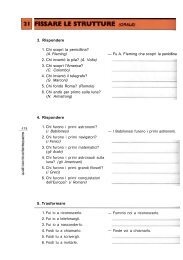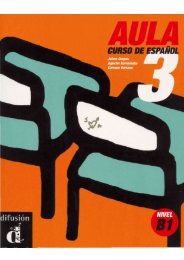III. The Beginnings of Transformation
III. The Beginnings of Transformation
III. The Beginnings of Transformation
You also want an ePaper? Increase the reach of your titles
YUMPU automatically turns print PDFs into web optimized ePapers that Google loves.
population. 131<br />
BEGINNINGS OF TRANSFORMATION<br />
Sometime later Christian Armenians retook it and engaged<br />
in reciprocal, destructive raids with their enemies the Muslim Armenians<br />
<strong>of</strong> Seveverek. 132<br />
First Muslims and Christians, and then Seljuks and<br />
Danishmendids, contested the city <strong>of</strong> Melitene and its neighboring<br />
villages so that for over a century this land knew no peace. It was one <strong>of</strong><br />
the first large Byzantine towns that the Seljuks sacked when they appeared<br />
in eastern Anatolia. 133<br />
endemic 134<br />
dids conquered it. 135<br />
By 1071 the Turkish raids in the environs were<br />
but the city held out until 1102 at which time the Danishmen<br />
kind to the inhabitants, 136<br />
Kïlïdj I Arslan took it in 1106, and though he was<br />
on his death the citizens were subjected to<br />
financial oppression by his successors. 137<br />
<strong>The</strong> environs <strong>of</strong>the city continued<br />
to be raided by Turks as well as by Franks. 138<br />
In 1124 the Danishmendid<br />
Ilghazi finally retook Melitene after a difficult six-month siege as a result<br />
<strong>of</strong>which the inhabitants perished in great numbers. 139<br />
In 1140-41 the<br />
Turks <strong>of</strong> Melitene pillaged the neighboring monastic establishment <strong>of</strong><br />
Zabar. 140<br />
Shortly afterward, when John Comnenus appeared before<br />
Neocaesareia, hopes seem to have run high among the Christians <strong>of</strong><br />
Melitene that he might succeed, with the result that the Turks put many<br />
inhabitants <strong>of</strong>Melitene to the sword. 141<br />
<strong>The</strong> struggle between Danishmen<br />
did and Seljuk over Melitene was continuous and between 1141 and 1143<br />
Mas'ud <strong>of</strong> Konya besieged the city. 142<br />
Raiding Turks pillaged and burned<br />
the monastic complex <strong>of</strong> Bar Mar Sauma a few years later. 143<br />
Kïlïdj II<br />
1 3 1<br />
Ibid., 205-206, he did this to chastise the Armenians who were raiding his lands. In<br />
1062 -63 the regions <strong>of</strong> Nisibis and Seveverek had been raided by the Khurasan Salar.<br />
Matthew <strong>of</strong> Edessa, pp. 115-118.<br />
1 3 2<br />
Michael the Syrian, <strong>III</strong>, 244, 247. Bar Hebraeus, I, 265. Matthew <strong>of</strong> Edessa, p. 313.<br />
<strong>The</strong> Armenian rulers <strong>of</strong> Seveverek had converted to Islam to keep their domains.<br />
1 3 3<br />
Matthew <strong>of</strong> Edessa, pp. 107-108. Bar Hebraeus, I, 212—213. Michael the Syrian,<br />
<strong>III</strong>, 165. Large numbers <strong>of</strong>its inhabitants were killed or enslaved. One source indicates<br />
that afterward some 15,000 prisoners were ransomed and returned to the city, Michael the<br />
Syrian, <strong>III</strong>, 146.<br />
1 3 4<br />
Cedrenus, II, 660. Attaliates, 93, 107. <strong>The</strong> attempt <strong>of</strong> Constantine X Ducas to<br />
enforce ecclesiastical union on the Monphysites <strong>of</strong> Melitene in 1063, and the fact that the<br />
Armenians raided the Syrian monasteries and attacked the Syrian populations <strong>of</strong> the<br />
countryside, added to the upheaval, Michael the Syrian, <strong>III</strong>, 161-164, 166-168. Bar<br />
Hebraeus, I, 217. Matthew <strong>of</strong> Edessa, pp. 95-96, 152-154.<br />
1 3 5<br />
Bar Hebraeus, I, 236. Matthew <strong>of</strong> Edessa, p. 230. In 1096-97 Kïlïdj I Arslan was<br />
besieging it when arrival <strong>of</strong> the Crusaders in Anatolia caused him to lift the siege.<br />
Michael the Syrian, <strong>III</strong>, 187. Matthew <strong>of</strong>Edessa, pp. 212-215. Danishmendwastedthe<br />
countryside, destroying the crops, in 1099.<br />
1 3 6<br />
1 3 7<br />
138<br />
Bar Hebraeus, I, 239. Michael the Syrian, <strong>III</strong>, 192.<br />
Michael the Syrian, <strong>III</strong>, 194.<br />
Ibid., 205.<br />
1 3 9<br />
<strong>The</strong> inhabitants suffered from three things: (1) the sword outside the wall which<br />
massacred those who fled; (2) famine; (3) <strong>The</strong> prince, who tortured the inhabitants in order<br />
to get their gold. Michael the Syrian, <strong>III</strong>, 219. Matthew <strong>of</strong> Edessa, p. 315.<br />
1 4 0<br />
Michael the Syrian, <strong>III</strong>, 248. Bar Hebraeus, I, 266.<br />
1 4 1<br />
Michael the Syrian, <strong>III</strong>, 249. Bar Hebraeus, I, 266; "At that time every Christian<br />
who mentioned the name <strong>of</strong> the King <strong>of</strong> the Greeks or <strong>of</strong>the Franks, even unwittingly, the<br />
Turks slew. And because <strong>of</strong> this many <strong>of</strong> the people <strong>of</strong> Melitene perished."<br />
1 4 2<br />
1 4 3<br />
158<br />
Michael the Syrian, <strong>III</strong>, 254. Bar Hebraeus, I, 267.<br />
Michael the Syrian, <strong>III</strong>, 290-291.






